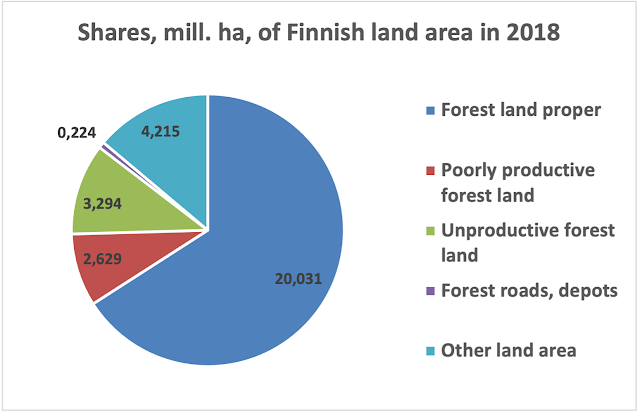Reference Carbon fluxes in Finnish Carbon husbandry
The important, key fluxes in Finnish Carbon husbandry are the two: (1) positive Carbon sink flux to Finnish forests and (2) negative Carbon emissions (source) flux from Finnish arable lands. The most accurate data in Finland have been measured for (1) in Finnish forests. In the year 2020 there is the calculated average Carbon sink flux to Finnish forests of magnitude +393 kg C/ha/a.
The most accurate data for Finnish arable lands (2) has been measured for mineral soils. In the year 2020 there is the calculated average Carbon emissions flux from Finnish arable lands of magnitude -430 kg C/ha/a. (Figure 1).
There is still less comprehensive measurement series for Carbon emissions from arable lands on peat soils. However, it is assumed that the emissions from a peat arable hectare are about 10 times the emissions from a mineral arable hectare. In climate change calculations the assumed Carbon emissions values are -7900 kg C/ha/a for annual crops (like cereals) and -5800 kg C/ha/a for perennial hay crops. Their average is -6800 kg C/ha/a (IPCC 2006).
Forests are the most important Carbon stock that can compensate at least part of the arable lands Carbon emissions. Peatlands are important in Finland both as forest lands and arable lands. Peatlands are also connected with climate campaign efforts as fuel peat has been an important energy source in Finland since the 1970s oil crisis. After fuel peat production the cutaway peat bogs are waiting for afforestation. Forestry science is looking for options how the cutaway peat bogs as well as all the well drained, or less well drained peatland forests could be Carbon sinks.
A remarkable possibility has been found from downy birch (Betula pubescens). It is an indigenous broadleaved tree in wide area of boreal zone, it grows relatively well in peatlands, it endures well arctic climate, and it endures relatively well browsing wild animals, and also pests and diseases.
Two recent studies, for Finland (Hytönen et al 2018) and for Estonia (Uri et al 2017) have shown that downy birch forests on cutaway peat bogs and well drained peatlands, can create a remarkable Carbon sink flux to the stems, branches, roots and organic soil layer.
The reference value (Figure 1) 3230 kg C/ha/a is based on natural downy birch forests in two Finnish cutaway peat bog area. The average Carbon sink flux in well drained Estonian peat bogs is comparable: 3450 kg C/ha/a.
The combination fuel peat - cutaway peat bogs - well drained peat bogs - downy birch is an interesting option also from the point of view of Carbon husbandry in boreal zone.
References
Hytönen, J. et al 2018. https://www.tandfonline.com/doi/abs/10.1080/02827581.2018.1500636?journalCode=sfor20
Uri, V. et al 2017. https://www.sciencedirect.com/science/article/abs/pii/S0378112717302268





Kommentit
Lähetä kommentti